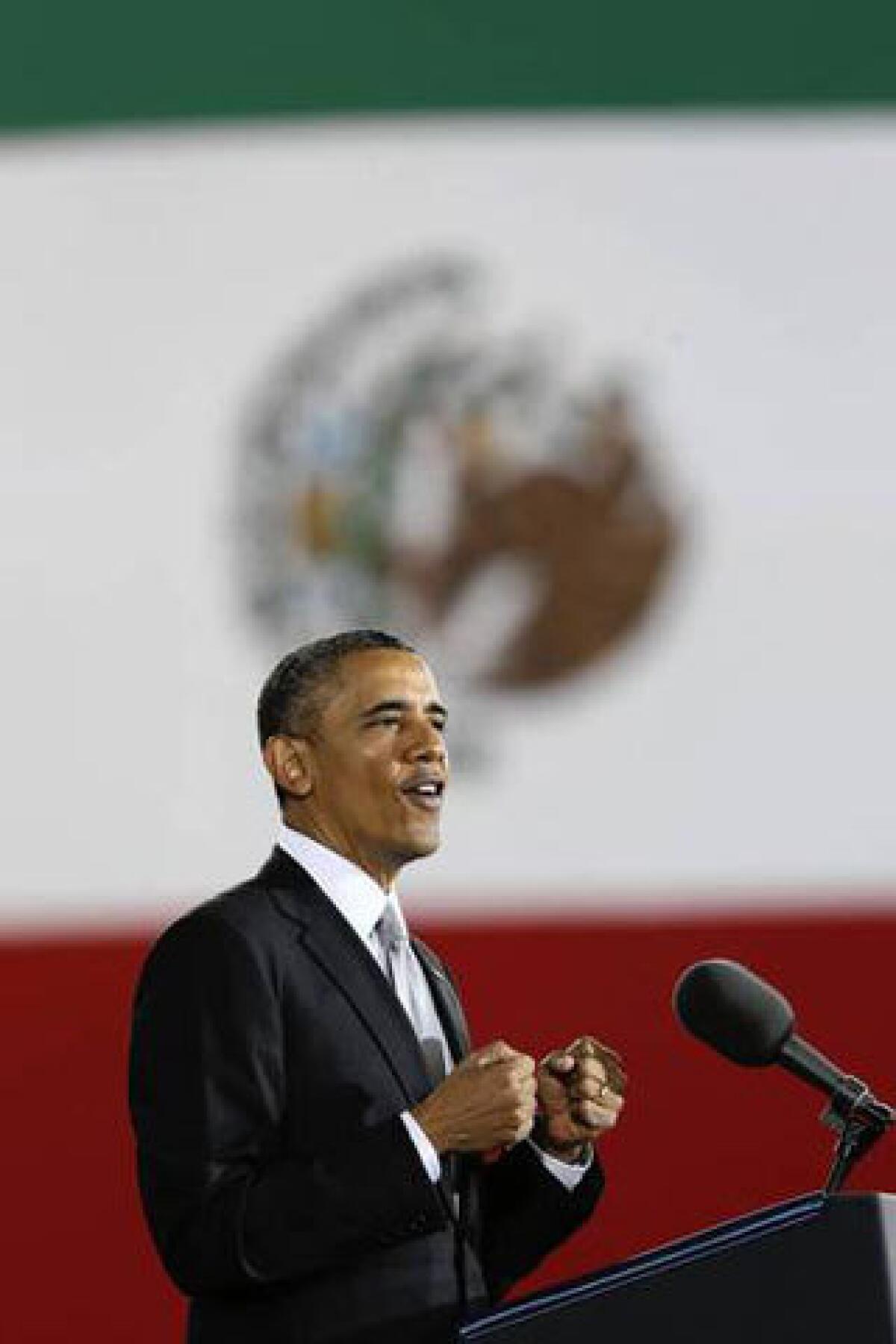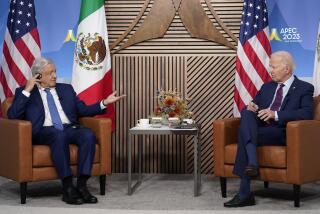Obama’s sunny speech in Mexico raises eyebrows

MEXICO CITY — President Obama on Friday painted a sunny picture of a modern Mexico emerging from its past troubles, an attempt at rebranding that serves the political aims of both governments but clashes with the realities of a country beset by violence and poverty.
On his second day of a swing through Latin America, Obama emphasized optimism about Mexico’s economic future and offered a broad endorsement of President Enrique Peña Nieto’s reform agenda. Speaking to a crowd largely made up of high school and college students, Obama pushed the next generation of Mexicans to continue to demand change.
“The young people of Mexico, you honor your heritage, thousands of years old, but you’re also part of something new, a nation that’s in the process of remaking itself,” he said in remarks that made reference to Twitter as well as the murals of Diego Rivera. “And as our modern world changes around us, it’s the spirit of young people … your willingness to discard old habits that are no longer working that will drive the world forward.”
The president’s speech, delivered in the central courtyard of the iconic National Museum of Anthropology, was the centerpiece of a three-day trip that also includes a stop in Costa Rica. Obama landed in San Jose later Friday for a meeting with several Central American leaders.
In both visits, Obama was aiming to steer the conversation away from the struggle to curb violence caused by the region’s drug war, and instead focus on economics, emphasizing new potential for trade and clean energy.
The perception of a rising Mexico serves both Obama’s and his counterpart’s domestic agendas. Obama’s push for immigration reform could be lifted by a perception that the causes of illegal immigration — poverty, violence and corrupt institutions — are easing under new Mexican leadership.
Obama was not subtle in hitting this point, quoting an unnamed Mexican man as saying, “There’s no reason to go abroad in search of a better life.” The U.S. president expressed new confidence that his immigration push was on track, saying, “We are going to get it done this year. I’m absolutely convinced of it.”
Peña Nieto’s reform agenda also could use a boost. After passing laws to overhaul education and telecommunications, he faces an uphill battle in opening up Mexico’s energy sector, especially oil exploration, to foreign investment. Such a move has long been taboo here.
Obama’s audience responded with enthusiasm, frequently interrupting him with applause or cheers. But audience members didn’t necessarily agree with his assessment.
“How nice that he came to give inspiring speeches, but what’s happening in Mexico is far from what he talked about today,” said Jose Carlos Cruz, a 24-year-old graduate student in international relations who attended the speech. “A really good speech by President Obama, but what Mexico was he talking about?”
The Mexican economy has begun to slow, and the decrease in illegal immigration is more likely a result of demographic changes, the sluggish U.S. economy and the severe dangers of crossing Mexico than of any improvements inside Mexico.
In his speech, Obama praised a growing middle class to which the majority of Mexicans belong. Although it is true that Mexico has a strong manufacturing base that has allowed many Mexicans to prosper, economists say the middle class has been stagnant for years. The World Bank says 49% of the population lives in poverty.
Obama lauded a courageous press that holds authorities accountable. Although the media in Mexico City fit that bill, violence and intimidation have silenced numerous newspapers outside the capital; many do not report on drug trafficking and other issues because of threats or bribes from criminals or local authorities.
The U.S.-Mexico relationship “must be defined not by the threats that we face but by the prosperity and the opportunity that we can create together,” Obama said.
Yet many among the several hundred people in attendance said he seemed too upbeat about their country.
“Obama is fantastic, but I believe that today he was talking about another country, not ours,” said Rosa Castro, 43, a college professor. “My question is: Who wrote Obama’s speech? Enrique Peña Nieto’s team?”
Alberto Rios Lara, 26, who is studying to be an economist, said, “Obama is a great speaker; it’s really impossible not to feel excited. However, the reality is different in Mexico. We need more action and fewer speeches.”
There were those in the audience moved by his vision.
“It was incredible to see Obama,” said student Maria Velazco, 18. “And I think that, like he said, a change is possible. A new Mexico is possible.”
The speech a fit a common pattern for Obama. Particularly when traveling to unstable or poor countries, he often opts to speak to young people, an audience that allows him to look ahead to a hopeful future rather than focusing on the present.
Obama was expected to take a somewhat firmer tone with the Central American leaders gathering in San Jose, a group whose records on human rights, corruption and security lags behind Mexico’s.
The president’s schedule included a one-on-one meeting with Costa Rican President Laura Chinchilla and a private working dinner with leaders from Nicaragua, Honduras, Panama, Belize, El Salvador, Guatemala and the Dominican Republic.
Obama is the first U.S. president to visit Costa Rica since Bill Clinton 15 years ago.
kathleen.hennessey@latimes.com
Times staff writer Richard Fausset and news assistant Cecilia Sanchez in Mexico City and staff writer Christi Parsons in Washington contributed to this report.
More to Read
Start your day right
Sign up for Essential California for news, features and recommendations from the L.A. Times and beyond in your inbox six days a week.
You may occasionally receive promotional content from the Los Angeles Times.








